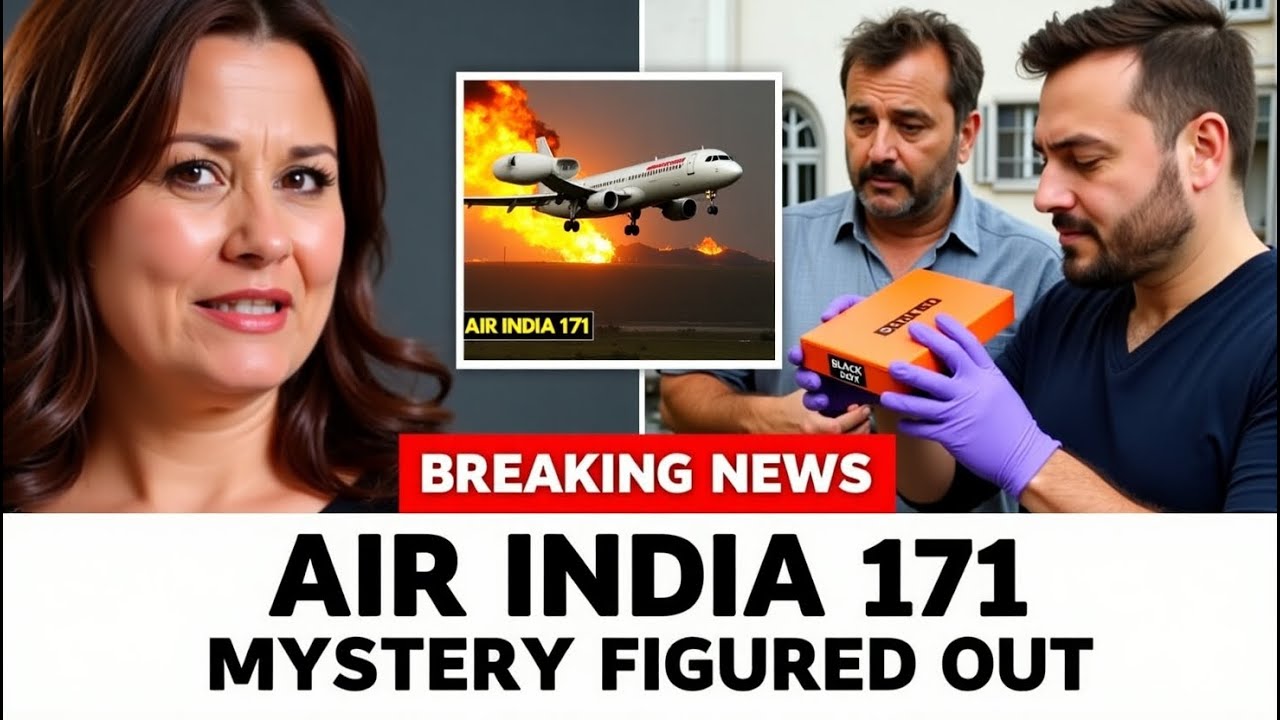🚨 SH0CKING REVEAL in Air India Flight 171 crash! Black box decoded: Was a shaky pilot seat to blame for the tragedy? 😱 The truth will leave you speechless!

Air India Flight 171: Unraveling the Mystery of a Shaky Seat and a Tragic Crash
On June 12, 2025, Air India Flight 171, a Boeing 787-8 Dreamliner, took off from Ahmedabad’s Sardar Vallabhbhai Patel International Airport, bound for London Gatwick. Less than 40 seconds later, the aircraft plummeted into the BJ Medical College hostel in a densely populated suburb, killing 241 of the 242 people on board and 19 on the ground. The sole survivor, Vishwash Kumar Ramesh, walked away from the wreckage, but the mystery of what caused this catastrophic crash—the first fatal accident involving a Boeing 787—has gripped the world. Recent reports suggest a decoded black box may point to a pilot struggling with a shaky seat in the cockpit’s final moments. But is this the full story, or does it mask deeper issues? This article explores the tragedy, the black box findings, and the questions that remain.
The Crash: A Timeline of Tragedy
At 13:38 local time (08:08 GMT), Flight 171, carrying 230 passengers and 12 crew members, lifted off from runway 23. The flight was commanded by Captain Sumeet Sabharwal, a seasoned pilot with over 15,600 flight hours, including 8,600 on the Boeing 787. First Officer Clive Kunder, with 3,400 hours, was the pilot flying, while Sabharwal monitored. The passenger manifest included 169 Indians, 53 British, 7 Portuguese, and 1 Canadian, reflecting the flight’s international scope.
Mere seconds after takeoff, at 08:08:42 GMT, both engine fuel control switches moved to the “cutoff” position, starving the engines of fuel and triggering a total power loss. Cockpit voice recorder (CVR) audio captured one pilot asking, “Why did you cut off?” with the other responding, “I did not.” The switches were returned to “run” within 10 seconds, initiating an automatic engine relight. The ram air turbine (RAT) deployed to provide emergency power, and a desperate “MAYDAY” call was issued at 08:09:05. Six seconds later, at 13:39:11, the aircraft crashed, ending all recordings.
The wreckage spread over 200 meters, devastating parts of the medical college hostel. Vishwash Kumar Ramesh, seated in 11A near an emergency exit, survived when his section of the aircraft detached, allowing him to escape through a broken exit. He sustained minor injuries and was released after five days in hospital, later attending his brother’s funeral, who perished in the crash.
The Black Box Revelation: A Shaky Seat?
The recovery of both black boxes—the CVR and Flight Data Recorder (FDR)—on June 13 and 16, respectively, marked a critical step in the investigation led by India’s Aircraft Accident Investigation Bureau (AAIB), with support from the U.S. National Transportation Safety Board (NTSB) and the UK’s Air Accidents Investigation Branch. Despite damage to the devices, data extraction was successful by June 25, revealing 49 hours of flight data and two hours of cockpit audio.
A preliminary AAIB report released on July 8, 2025, highlighted the fuel control switches’ movement as a key factor. The switches, located behind the throttle levers, require deliberate action to move from “run” to “cutoff” due to their spring-loaded design. The report noted no evidence of bird strikes, hydraulic failures, or center-of-gravity issues, ruling out some initial theories.
Recent reports, including a speculative claim, suggest the pilot’s actions may have been influenced by a “shaky seat.” This theory posits that Captain Sabharwal or First Officer Kunder, while attempting to steady themselves, inadvertently moved the fuel switches. Such a scenario raises questions about cockpit ergonomics and human factors in high-stress environments. However, the AAIB has not officially confirmed this, and the Airline Pilots’ Association of India (ALPA) has criticized premature blame on the pilots, calling for transparency and caution against speculative narratives.
Critical Examination: Was It Really the Seat?
The “shaky seat” theory, while intriguing, demands scrutiny. The fuel control switches on a Boeing 787 are designed to prevent accidental movement, requiring a pilot to pull upward before shifting. Experts like Mary Schiavo have urged caution, noting no definitive evidence of pilot error. Former accident investigator Shawn Pruchnicki emphasized that such an error would be unusual without evident cockpit confusion, which the CVR does not indicate.
Simulator experiments conducted by Air India training captains post-crash found that the aircraft could climb safely with one engine, even with flaps retracted and landing gear down, suggesting a dual-engine failure should not have been catastrophic at the flight’s low altitude of 625 feet. This raises doubts about whether a shaky seat alone could account for both switches being flipped simultaneously.
Alternative theories include mechanical or electrical anomalies. A 2020 incident involving a Titan Airways A321 at London Gatwick, where fuel contamination caused a dual-engine anomaly, was reviewed as a precedent, though no such contamination has been confirmed for Flight 171. The failure to retract the landing gear, visible in crash footage, suggests possible hydraulic or electrical issues, though the RAT’s deployment should have provided emergency power.
The absence of cockpit video recorders, as noted by the NTSB and The Air Current, complicates the investigation. Video could have clarified which pilot, if any, touched the switches, reducing reliance on ambiguous audio. This gap has fueled calls for mandatory cockpit video, a debate reignited by Flight 171’s unresolved questions.
Human and Systemic Factors
Both pilots were experienced and had passed pre-flight breathalyzer tests, with adequate rest before the flight. Captain Sabharwal, known for his meticulousness, was a mentor to junior pilots, while Kunder was described as humble and dedicated. Their families, rooted in aviation, were devastated, with Sabharwal’s elderly father left in shock.
Air India’s maintenance regime has come under scrutiny, with the Indian regulator ordering additional checks on its 33 remaining 787s. A 2019 FAA bulletin highlighted issues with fuel control switches on some Boeing aircraft, though not deemed critical enough for mandatory action. Air India did not inspect these switches, a decision now questioned.
The tragedy’s human toll is staggering. Families await DNA identification of victims, with only 35 bodies released by June 15. Tata Group, Air India’s parent, announced ₹10 million (US$120,000) per deceased passenger, with additional liability under the Montreal Convention. A multi-faith vigil in London and candlelight vigils in Ahmedabad reflected global mourning.
Unanswered Questions and Moving Forward
The “shaky seat” theory, while compelling for its human element, feels incomplete without corroborating evidence. Was it a freak ergonomic failure, or a symptom of broader systemic issues—cockpit design, maintenance oversights, or undetected mechanical faults? The CVR’s ambiguity, lacking clear voice identification, underscores the need for cockpit video, as advocated by experts like Peter Goelz.
The AAIB’s final report, expected within 12 months per ICAO protocols, will likely clarify whether human error, mechanical failure, or an unlikely act of sabotage caused the crash. Until then, speculation must be tempered, as urged by the Indian Commercial Pilots’ Association, to avoid unjustly tarnishing the pilots’ reputations.
Flight 171’s legacy may extend beyond its tragedy, potentially driving reforms in cockpit design, video recording mandates, and maintenance protocols. For now, the world mourns 260 lives lost and awaits answers to ensure such a disaster is not repeated.





